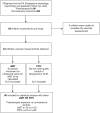Intrauterine exposure to preeclampsia does not impair vascular health in children
- PMID: 36620255
- PMCID: PMC9814159
- DOI: 10.3389/fpubh.2022.1071304
Intrauterine exposure to preeclampsia does not impair vascular health in children
Abstract
Background and objectives: Preeclampsia is a serious multisystem blood pressure disorder during pregnancy that is associated with increased long-term risk of cardiovascular disease to the mother and offspring. We investigated the vascular health of children exposed to intrauterine preeclampsia.
Materials and methods: This was a cross-sectional study of offspring in a prospective cohort of women with complications during pregnancy. Children aged between 2 and 5 years [median age 4.7 (2.8, 5.1) years] exposed to intrauterine preeclampsia (n = 26) or normotensive controls (n = 34), were recruited between July 2020 and April 2021. Vascular health was assessed by measuring aortic intima-media thickness and pulse wave velocity. Univariate generalized linear regression models were used to explore associations between vascular measurements and explanatory variables.
Results: Children exposed to preeclampsia had a lower body mass index at assessment (15.5 vs. 16.2 kg/m2, p = 0.04), birth weight (2.90 vs. 3.34 kg, p = 0.004), gestational age at birth (37.5 vs. 39.4 weeks, p < 0.001) and higher frequency of preterm birth (27% vs. 6%, p = 0.02). There were no differences in vascular health between children exposed to preeclampsia vs. controls (mean aortic intima-media thickness 0.575 mm vs. 0.563 mm, p = 0.51, pulse wave velocity 4.09 vs. 4.18 m/s, p = 0.54) and there were no significant associations in univariate analyses.
Conclusions: There were no major adverse differences in vascular health which contrasts with existing studies. This suggests exposure to intrauterine preeclampsia may result in a less severe cardiovascular phenotype in young children. While reassuring, longitudinal studies are required to determine if and when exposure to intrauterine preeclampsia affects vascular health in children.
Keywords: aortic intima-media thickness; children; early arterial injury; preeclampsia; pulse wave velocity.
Copyright © 2022 Varley, Henry, Roberts, Davis, Skilton, Craig and Gow.
Conflict of interest statement
The authors declare that the research was conducted in the absence of any commercial or financial relationships that could be construed as a potential conflict of interest.
Figures
References
Publication types
MeSH terms
LinkOut - more resources
Full Text Sources
Miscellaneous



